| Skip Navigation Links | |
| Exit Print View | |

|
Sun Server X4-2L HTML Documentation Collection |
Getting the Latest Software and Firmware
About the Installation Procedure
Installation Procedure Overview
Preparing for Server Installation
Server Physical Specifications
Tools and Equipment Needed for Installation
Optional Component Installation
About Server Features and Components
Front Panel Status Indicators, Connectors, and Drives
Back Panel Status Indicators, Connectors, Drives, and PCIe Slots
Server Management Software Overview
Getting Server Firmware and Software Updates
Firmware and Software Access Options
Getting Firmware and Software From MOS or PMR
Installing Updates Using Other Methods
Installing the Server Into a Rack
Safety Precautions When Rackmounting the Server
Stabilize the Rack for Installation
Attach Tool-less Slide-Rail Assemblies
Install the Server Into the Slide-Rail Assemblies
Install the Second-Generation Cable Management Arm
Remove the Second-Generation Cable Management Arm
Install the First-Generation Cable Management Arm
Verify Operation of Slide-Rails and CMA
Rear Cable Connections and Ports
Attaching Data Cables to the Server
Connecting Power Cords to the Server
Oracle ILOM Hardware and Interfaces
Logging In to Oracle ILOM Using a Local Serial Connection
Logging In to Oracle ILOM Using a Remote Ethernet Connection
Accessing the Host Console Through Oracle ILOM
Troubleshooting the Service Processor Connection
Setting Up Software and Firmware Using Oracle System Assistant
Accessing Oracle System Assistant
Setting Up Software and Firmware Using Oracle System Assistant
Set Up Software and Firmware Using Oracle System Assistant
Setting Up an Operating System and Drivers
Configuring Server Drives for OS Installation
RAID Configuration Requirements
Configuring Storage Drives Into RAID Volumes Using Oracle System Assistant
Configuring RAID Using the BIOS RAID Configuration Utilities
Configuring the Preinstalled Oracle Solaris 11.1 Operating System
Preinstalled Oracle Solaris 11.1 Image BIOS Boot Mode Restriction
Preinstalled Operating System RAID Limitations
Oracle Solaris 11.1 Configuration Worksheet
Configure the Preinstalled Oracle Solaris 11.1 Operating System
Oracle Solaris 11.1 Operating System Documentation
Configuring the Preinstalled Oracle Linux 6. x Operating System
Preinstalled Oracle Linux Image BIOS Boot Mode Restriction
Oracle Linux 6.x Configuration Worksheet
Configure the Preinstalled Oracle Linux 6.x Operating System
Registering Oracle Linux and Activating Automatic Update
Oracle Linux 6.x Operating System Documentation
Configuring the Preinstalled Oracle VM 3.2 Software
Preinstalled Oracle VM Image BIOS Boot Mode Restriction
Preinstalled Oracle VM Server and Oracle VM Manager Compatibility Requirements
Oracle VM Server Configuration Worksheet
Configure the Preinstalled Oracle VM Server
Powering Off the Server for Orderly Shutdown
Powering Off the Server for Immediate Shutdown
Troubleshooting Installation Issues
Technical Support Information Worksheet
Locating the System Serial Number
About Oracle Solaris Operating System Installs
Oracle Solaris OS Installation Task Map
Selecting the Console Display Option
Selecting the Boot Media Option
Selecting the Installation Target Option
Oracle Solaris OS Installation Options
Oracle System Assistant Overview
Preparing to Install the Operating System
Installing the Oracle Solaris Operating System
Installing Oracle Solaris on a Single System Using Oracle System Assistant
Installing the Oracle Solaris 10 or 11 Operating System on a Single System Using Media
Oracle VM Installation Task Map
Selecting the Console Display Option
Selecting the Boot Media Option
Selecting the Installation Target Option
Oracle VM Installation Options
Oracle System Assistant Overview
Preparing to Install Oracle VM
Verify the BIOS Factory Defaults
Disable VT-d and SR-IOV in BIOS
Installing Oracle VM on a Single System Using Oracle System Assistant
Installing Oracle VM on a Single System Using Media
Post Installation Tasks for Oracle VM
Configuring Network Interfaces
About Linux Operating System Installs
Supported Linux Operating Systems
Oracle Unbreakable Enterprise Kernel for Linux
Selecting the Console Display Option
Selecting the Boot Media Option
Selecting the Installation Target Option
Oracle System Assistant Overview
Preparing to Install the Operating System
Installing a Linux Operating System
Installing a Linux OS on a Single System Using Oracle System Assistant
Installing Oracle Linux on a Single System Using Media
Installing Red Hat Enterprise Linux on a Single System Using Media
Installing SUSE Linux Enterprise Server on a Single System Using Media
Configuring Network Interfaces
About Microsoft Windows Server Operating System Installs
Windows OS Installation Task Map
Supported Windows Operating Systems
SAS PCIe HBAs Requiring LSI Mass Storage Driver for Windows Server 2008 SP2
Selecting the Console Display Option
Selecting the Boot Media Option
Selecting the Installation Target Option
Windows OS Installation Options
Oracle System Assistant Overview
Preparing to Install the Operating System
Installing a Windows Server Operating System
Installing Windows Server on a Single System Using Oracle System Assistant
Install Windows Server on a Single System Using Oracle System Assistant
Installing Windows Server on a Single System Using Media
Install Windows Server 2012 or 2012 R2 Using Local or Remote Media
Install Windows Server 2008 (SP2 or R2 SP1) or Windows Server 2012 Using PXE Network Boot
Post Installation Tasks for Windows Server
Supplemental Software Component Options
Installing Device Drivers and Supplemental Software
VMware ESXi Installation Task Map
Supported VMware ESXi Software
Selecting the Console Display Option
Selecting the Boot Media Option
Selecting the Installation Target Option
VMware ESXi Installation Options
Preparing to Install VMware ESXi
Configuring the VMware ESXi 5.0 Software or the Server Hardware to Support Network Connections
Installing VMware ESXi on a Single System Using Media
Post Installation Tasks for VMware ESXi
Configure Network Adapter Settings
Determine the MAC Address of a Connected Server Network Port
Update the VMware ESXi Software
Configuring Network Interfaces
About Server and Component Status Indicators
Service Troubleshooting Task List
Locate the Server Serial Number
Electrostatic Discharge Safety
Preparing the Server for Component Replacement
Servicing CRUs That Do Not Require Server Power-Off
Servicing Storage Drives and Rear Drives (CRU)
Servicing Power Supplies (CRU)
Servicing CRUs That Require Server Power-Off
Servicing the SAS Expander Module (CRU)
Servicing the Air Baffle (CRU)
Servicing the Internal USB Flash Drives (CRU)
Servicing the Front and Rear Storage Drive Backplanes (FRU)
Servicing the Front LED/USB Indicator Modules (FRU)
Servicing the Motherboard Assembly (FRU)
Returning the Server to Operation
Server Filler Panel Requirements
Remove and Install Filler Panels
Reinstall the Server Chassis in the Rack
Return the Server to the Normal Rack Position
Reconnect Power and Data Cables
Setting Up BIOS Configuration Parameters
Managing the BIOS Configuration
Accessing the BIOS Setup Utility
Using BIOS for Resource Allocation
Common BIOS Setup Utility Tasks
BIOS Setup Utility Menu Options
UEFI Driver Control Menu Selections
BIOS Save & Exit Menu Selections
Monitoring Components and Identifying SNMP Messages
Monitoring Component Health and Faults Using Oracle ILOM
This procedure describes how to boot the Microsoft Windows Server 2008 (SP2 or R2 SP1) operating system from local or remote media. It assumes that you are booting the Windows installation media from one of the following sources:
Windows Server 2008 SP2 or Windows Server 2008 R2 SP1 CD or DVD
Windows Server 2008 SP2 or Windows Server 2008 R2 SP1 ISO image
Note - The Windows Server 2008 (SP2 or R2 SP1) ISO image can be used for remote installation or for creating an installation CD or DVD.
Note - If you are booting the installation media from a PXE environment, refer to Install Windows Server 2008 (SP2 or R2 SP1) or Windows Server 2012 Using PXE Network Boot for instructions.
For additional information about how to set up the installation media, see Selecting the Boot Media Option.
For example:
The BIOS screen appears.

Note - The next events occur very quickly; therefore, focused attention is needed for the following steps. Watch carefully for these messages as they appear on the screen for a brief time. You might want to enlarge the size of your screen to eliminate scroll bars.
The Please Select Boot Device menu appears. The screen that appears will be different depending on whether you have BIOS configured for Legacy mode or UEFI mode.
For Legacy BIOS, a screen similar to the following appears:
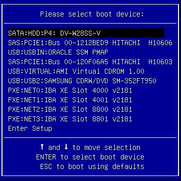
For UEFI BIOS, a screen similar to the following appears:
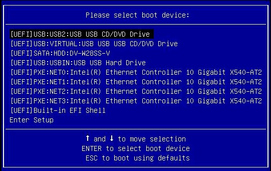
Note - The boot device menu that appears in your installation might differ depending on the type of disk controller installed in your server.
For example:
The Windows installation wizard starts.
Continue the Windows installation wizard until the Language Localization dialog appears.

The Select Operating System dialog appears.
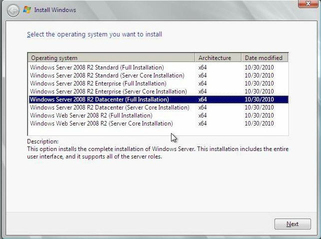
Note - The above dialog varies depending on the type Windows software license: Educational, Volume, or Retail.
The Installation Type dialog appears.
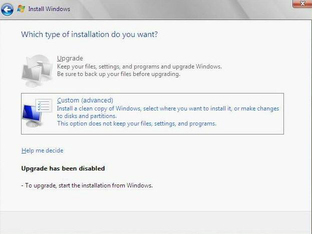
The Where Do You Want to Install Windows dialog appears.

(This task only applies to Windows Server 2008 SP2 installations) If you do not see any storage targets listed and have a Sun Storage SAS PCIe RAID HBA option configured on your server, click Load Driver, then proceed to Step 10.
- or -
If you see the storage target where you want to install the operating system but want to change the default partition settings associated with that target, select the target, click Drive Options (Advanced), then proceed to Step 11.
- or -
If you see the storage target where you want to install the operating system and do not want to change the default partition settings for that target, select the target and click Next, then proceed to Step 12.
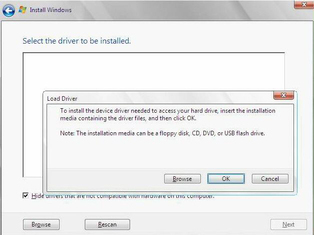
For example:
For a system configured with the Sun Storage 6 Gb SAS PCIe RAID HBA option (SG-SAS6-R-INT-Z), navigate to the following directory on the internal Oracle System Assistant USB flash drive to load the appropriate LSI driver: windows/w2k8/drivers/LSI-HBA-MegaSAS2
For a system configured with either of these Sun Storage 6 Gb SAS PCIe HBA options: SG-SAS6-INT-Z or SG-SAS6-EXT-Z, navigate to the following directory on the internal Oracle System Assistant USB flash drive to load the appropriate LSI driver: windows/w2k8/drivers/LSI-HBA-MPT2
The selected driver appears in the Select the Driver to Be Installed dialog.
For example:
Two example dialogs follow showing the selected driver to be installed for the two SAS PCIe HBA options. Note that the SAS PCIe HBA drivers are required only for Windows Server 2008 SP2 installations.
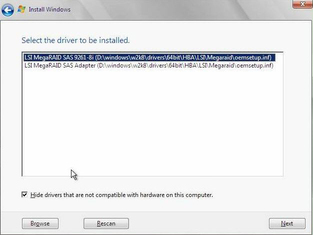
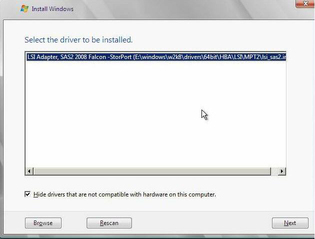
The Where Do You Want to Install Windows dialog appears.
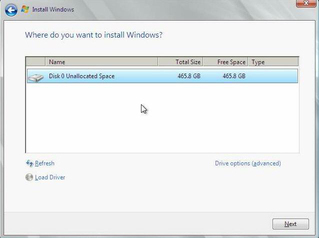
Note - If you previously removed or unmounted the Windows Server install media to load the drivers from the internal Oracle System Assistant USB flash drive, you might see the following message: Windows Cannot be installed to this disk. If this message appears, insert or re-mount the Windows install media, then click Refresh.
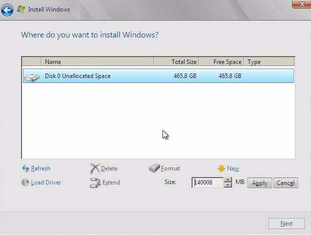
A confirmation window appears.
Note - Windows Server 2008 enforces stricter password schemes for user accounts. Password standards include restrictions on length, complexity, and history. For more details, click the Accessibility link at the account creation page.
After the initial user account is created, the Windows Server 2008 desktop appears.